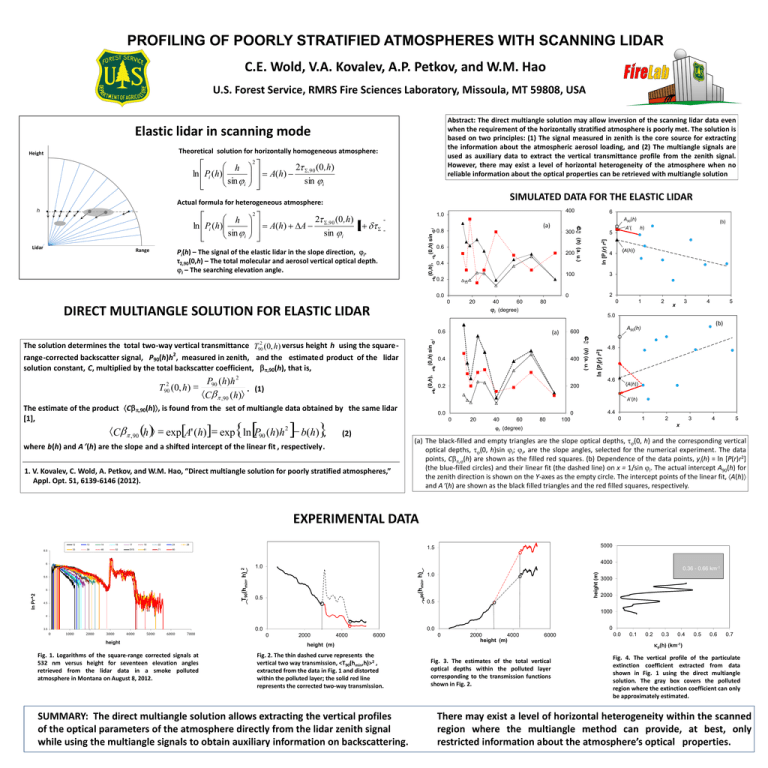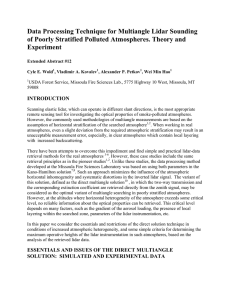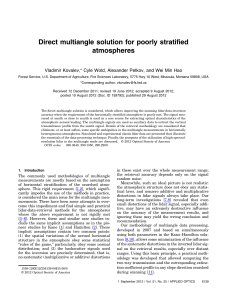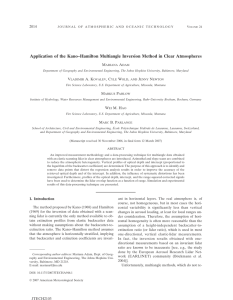PROFILING OF POORLY STRATIFIED ATMOSPHERES WITH SCANNING LIDAR
advertisement

PROFILING OF POORLY STRATIFIED ATMOSPHERES WITH SCANNING LIDAR C.E. Wold, V.A. Kovalev, A.P. Petkov, and W.M. Hao U.S. Forest Service, RMRS Fire Sciences Laboratory, Missoula, MT 59808, USA Abstract: The direct multiangle solution may allow inversion of the scanning lidar data even when the requirement of the horizontally stratified atmosphere is poorly met. The solution is based on two principles: (1) The signal measured in zenith is the core source for extracting the information about the atmospheric aerosol loading, and (2) The multiangle signals are used as auxiliary data to extract the vertical transmittance profile from the zenith signal. However, there may exist a level of horizontal heterogeneity of the atmosphere when no reliable information about the optical properties can be retrieved with multiangle solution Elastic lidar in scanning mode Theoretical solution for horizontally homogeneous atmosphere: h ln Pi (h) sin 2 A(h) i 2 ,90 (0 , h ) sin i SIMULATED DATA FOR THE ELASTIC LIDAR Actual formula for heterogeneous atmosphere: Range sin i (0 , h ) 1 i A ,90 i (0,h), Pi(h) – The signal of the elastic lidar in the slope direction, i. τΣ,90(0,h) – The total molecular and aerosol vertical optical depth. i – The searching elevation angle. A90(h) (a) 0.8 6 300 0.6 200 0.4 A'( 5 (h) (a. u.) Lidar A(h) 2 400 1.0 C h ln Pi (h) sin 2 (0,h) sin h ln [Pi(r) r2] Height A(h) 4 100 3 0 2 h) 0.2 0.0 0 DIRECT MULTIANGLE SOLUTION FOR ELASTIC LIDAR 20 40 i 60 0 80 The estimate of the product C [1], C ,90(h) , 90 (a) 400 ln [Pi(r) r2] 0.4 4.8 4.6 0.2 A(h) 200 0.0 exp ln P90 (h)h 2 b( h) , (2) where b(h) and A (h) are the slope and a shifted intercept of the linear fit , respectively . 1. V. Kovalev, C. Wold, A. Petkov, and W.M. Hao, “Direct multiangle solution for poorly stratified atmospheres,” Appl. Opt. 51, 6139-6146 (2012). 4.4 0 0 exp A' (h) (b) A'(h) , is found from the set of multiangle data obtained by the same lidar h 5 A90(h) 600 i (0,h) sin (0,h), T (0, h) 4 5.0 (h) (a. u.) 2 90 P90 (h)h . (1) C ,90 (h) 3 x C 2 2 (degree) 0.6 The solution determines the total two-way vertical transmittance T902 (0, h) versus height h using the square range -corrected backscatter signal, P90(h)h2, measured in zenith, and the estimate d product of the lidar solution constant, C, multiplied by the total backscatter coefficient, ,90(h), that is, 1 20 40 60 i (degree) 80 0 100 1 2 3 4 5 x (a) The black-filled and empty triangles are the slope optical depths, (0, h) and the corresponding vertical optical depths, (0, h)sin i; i, are the slope angles, selected for the numerical experiment. The data points, C , (h) are shown as the filled red squares. (b) Dependence of the data points, yi(h) = ln [P(r)r2] (the blue-filled circles) and their linear fit (the dashed line) on x = 1/sin i. The actual intercept A90(h) for the zenith direction is shown on the Y-axes as the empty circle. The intercept points of the linear fit, A(h) and A (h) are shown as the black filled triangles and the red filled squares, respectively. EXPERIMENTAL DATA 15 17 19 22 24 33 39 46 52 SYS 61 71 80 28 T90(hmin, h) 2 6 5.5 ln Pr^2 5 5000 1.5 4000 1.0 0.36 - 0.66 km-1 height (m) 14 h) 13 1.0 90(hmin, 6.5 12 0.5 3000 2000 0.5 4.5 1000 4 3.5 0 1000 2000 3000 4000 5000 6000 7000 height Fig. 1. Logarithms of the square-range corrected signals at 532 nm versus height for seventeen elevation angles retrieved from the lidar data in a smoke polluted atmosphere in Montana on August 8, 2012. 0 0.0 0.0 0 2000 4000 6000 height (m) Fig. 2. The thin dashed curve represents the vertical two way transmission, <T90(hmin,h)>2 , extracted from the data in Fig. 1 and distorted within the polluted layer; the solid red line represents the corrected two-way transmission. SUMMARY: The direct multiangle solution allows extracting the vertical profiles of the optical parameters of the atmosphere directly from the lidar zenith signal while using the multiangle signals to obtain auxiliary information on backscattering. 0 2000 4000 height (m) 6000 0.0 0.1 0.2 0.3 p(h) Fig. 3. The estimates of the total vertical optical depths within the polluted layer corresponding to the transmission functions shown in Fig. 2. 0.4 0.5 0.6 0.7 (km-1) Fig. 4. The vertical profile of the particulate extinction coefficient extracted from data shown in Fig. 1 using the direct multiangle solution. The gray box covers the polluted region where the extinction coefficient can only be approximately estimated. There may exist a level of horizontal heterogeneity within the scanned region where the multiangle method can provide, at best, only restricted information about the atmosphere’s optical properties.








